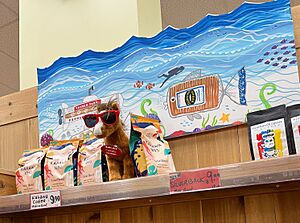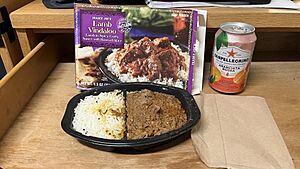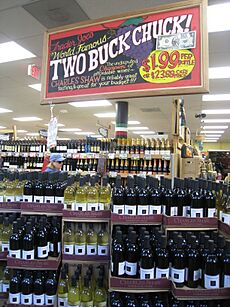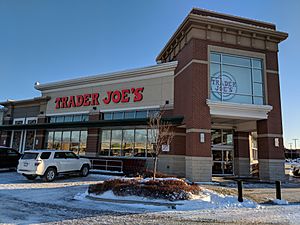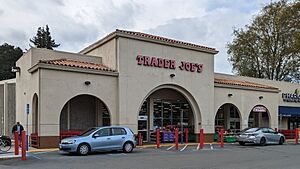Trader Joe's facts for kids
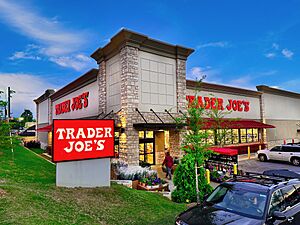
Trader Joe's in Chattanooga, Tennessee
|
|
|
Trade name
|
Trader Joe's |
|---|---|
| Private | |
| Industry | Retail (grocery) |
| Founded |
|
| Founder | Joe Coulombe |
| Headquarters |
Monrovia, California, U.S.
|
|
Number of locations
|
608 |
|
Area served
|
Contiguous United States |
|
Key people
|
Bryan Palbaum (chairman & CEO) |
| Products | Private label staple foods, organic foods and specialty products |
| Revenue | |
| Owner | Three foundations of the Albrecht Family |
|
Number of employees
|
50,000+ |
Trader Joe's is a popular American grocery store chain. Its main office is in Monrovia, California. There are 608 Trader Joe's stores across the United States.
The very first Trader Joe's store opened in 1967. It was started by Joe Coulombe in Pasadena, California. Later, in 1979, Theo Albrecht, who also helped start the Aldi stores, bought the company. Today, Trader Joe's is owned by three foundations of the Albrecht family. The company also has offices in Boston, Massachusetts.
Contents
The Story of Trader Joe's
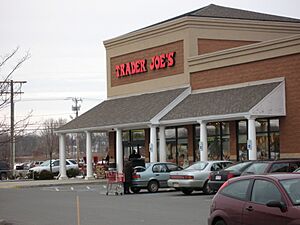
Trader Joe's is named after its founder, Joe Coulombe. The company actually started in 1958 as a chain of small convenience stores called Pronto Market. These stores were mostly in the Greater Los Angeles area. Joe Coulombe felt that his Pronto Markets were too much like other big convenience stores. He worried they wouldn't be able to compete.
Joe Coulombe got the idea for the "Trader Joe's" theme while on a trip to the Caribbean. He wanted his new stores to feel like a fun, adventurous place. The name "Trader Joe's" was a playful nod to "Trader Vic's," a famous restaurant with a similar island theme. While Trader Vic's was very fancy and expensive, Trader Joe's offered unique foods and drinks at more affordable prices. Joe noticed that more people were going to college and traveling more. They were looking for interesting foods that regular supermarkets didn't offer.
The first store named "Trader Joe's" opened in 1967 in Pasadena, California. This original store is still open today! In the early years, some stores even had butchers who sold fresh meat. They also offered sandwiches and freshly cut cheese.
In 1979, Theo Albrecht, who was the owner of Aldi Nord, bought Trader Joe's. Joe Coulombe was later followed as CEO by his friend, John V. Shields, in 1987. Under John's leadership, Trader Joe's grew and opened stores in Arizona and the Pacific Northwest. In 1996, the company opened its first stores on the East Coast, near Boston.
In 2001, John Shields retired, and Dan Bane became the new CEO. Trader Joe's has continued to grow across the United States. The company has been very successful, selling a lot of products from its stores. Joe Coulombe, the founder, passed away in 2020. Dan Bane retired as CEO in July 2023. Bryan Palbaum, who used to be the company's president, took over as the new CEO. Jon Basalone also became the vice-CEO and president.
Where You Can Find Trader Joe's
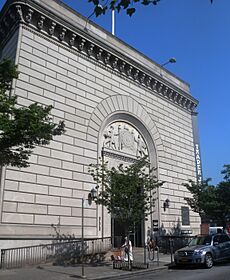
As of July 2025, Trader Joe's has 608 stores. These stores are located in 43 states and also in Washington, D.C.. New stores are always being added. Most Trader Joe's stores are about the size of a large gym. California has the most Trader Joe's stores, with 205 locations. The busiest Trader Joe's store is in Manhattan, New York City. The smallest store is in Boston, Massachusetts.
Each Trader Joe's store is designed to feel like the neighborhood it's in. Staff members often create cool murals on the walls that show local landmarks. Some stores even have a fun "find the mascot" game for kids. Children can get stickers and lollipops if they find the hidden mascot.
Store Locations and Neighborhoods
Trader Joe's is known for having good prices. However, most of its stores are in neighborhoods where people earn more money. In 2022, a typical Trader Joe's customer was often a married person living in a city. They were usually between 25 and 44 years old and earned at least $80,000. When Trader Joe's decides where to open a new store, they often look for areas where the average household income is over $100,000.
Sometimes, opening a Trader Joe's store can lead to changes in a neighborhood. For example, in 2014, Trader Joe's planned to open a store in a historic neighborhood in Portland, Oregon. Some local groups protested because they worried it would change the neighborhood too much. They were concerned about the city giving money to Trader Joe's. They felt it could lead to people being forced out of their homes. After these protests, Trader Joe's decided not to open a store there. Instead, a different grocery store was built on that spot.
What You Can Buy at Trader Joe's
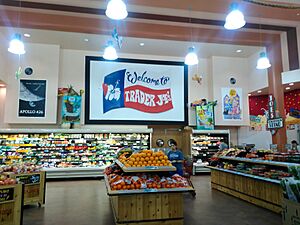
Trader Joe's Own Brands
Trader Joe's sells many products under its own brand names. These are called "private labels." They are often much cheaper than similar products from other well-known brands. Trader Joe's buys directly from farmers and suppliers, which helps keep prices low. The company has been criticized sometimes for making products similar to those from smaller companies.
A typical grocery store might sell 50,000 different items. But Trader Joe's only sells about 4,000 items. About 80% of these items are Trader Joe's own brands. You can find special foods, organic foods, vegan and vegetarian foods, frozen foods, and foods from other countries. They also sell wine and beer where it's allowed by law.
For many years, Trader Joe's used different names for its international foods. For example, "Trader José" was for Mexican products, "Trader Joe San" for Japanese, and "Trader Giotto" for Italian. In July 2020, some people asked the company to change these names. They felt the names were not respectful and promoted stereotypes.
Trader Joe's said they were already planning to change some of these names back to "Trader Joe's." They also said they didn't think the names were racist. They explained that they don't make decisions based on online petitions.
Products You Might Not Always Find
Trader Joe's often stops selling certain products more often than other grocery stores. A product might be discontinued for a few reasons. It could be a seasonal item, meaning it's only sold at certain times of the year. The cost to make the item might have gone up. Or, the item might not have been selling very well. Trader Joe's introduces new items every week. So, they sometimes remove older items to make space for the new ones. Many stores have a "new items" section to show off their latest products.
The products and prices can also be different from state to state. For fresh items like dairy or juice, Trader Joe's tries to get them from nearby suppliers. This can cause small differences in recipes and prices. State laws and taxes can also affect how products are priced in each location.
In 2008, Trader Joe's announced they would stop selling products from China that had only one ingredient. This was because some customers had concerns.
Cage-Free Eggs
In February 2016, Trader Joe's announced a goal. They wanted all the eggs they sold in western states to come from cage-free chickens by 2020. Their goal was for all eggs sold nationwide to be cage-free by 2025.
In 2018, there was a lawsuit about how Trader Joe's labeled its cage-free eggs. The lawsuit said that the pictures on the egg cartons showed chickens outside in fields. But the eggs actually came from chickens that didn't have outdoor access. Trader Joe's agreed to change the packaging on these eggs across the country.
Famous Wine
Trader Joe's is the only store that sells Charles Shaw wine. This wine is often called "Two Buck Chuck" because it used to cost only $1.99 in California. The price can be different in other places. Joe Coulombe once said that Trader Joe's became popular because of its wine first, then its food. He tasted many wines to find good ones for the store. Over a billion bottles of "Two Buck Chuck" have been sold. The company doesn't put the names of the wineries on the labels.
Most Popular Items
Every year, Trader Joe's asks its customers about their favorite products. In January 2023, the survey results showed that the Chili & Lime Flavored Rolled Tortilla Chips were the most popular overall product. They were also the favorite snack. Other favorites included:
- Sparkling Honeycrisp Apple Juice (favorite drink)
- Trader Joe's Cheddar Cheese with Caramelized Onions (favorite cheese)
- Trader Joe's Butter Chicken (favorite main meal)
- Seasonal candles (favorite household item)
- Bananas (favorite fruit or vegetable)
- Hold the Cone! Mini Ice Cream Cones (favorite dessert)
- Cashew & Basil Pesto (favorite vegan/vegetarian item)
Some past winners are now in the store's "Product Hall of Fame."
Being Eco-Friendly
Trader Joe's says it tries to be sustainable. This means they work to protect the environment and prevent food waste.
The company has been criticized for not always sharing where its products come from. For example, they don't share much about how they get their organic milk. Trader Joe's also scores low on how well they address child labor or deforestation related to the chocolate they sell.
In 2016, Trader Joe's made an agreement with the government. This was because they were accused of releasing harmful gases from their refrigerators. The company agreed to reduce these emissions and track them better. They also had to use more eco-friendly refrigerants in some stores. However, they haven't shared much public information about their progress since then.
Better Packaging
Trader Joe's has been working to make its product packaging more environmentally friendly. In 2019, a group called Greenpeace collected many signatures asking Trader Joe's to stop using so much single-use plastic. Because of customer requests, Trader Joe's promised to:
- Stop offering single-use plastic bags at checkout.
- Use bags for produce that can break down naturally.
- Replace styrofoam trays.
- Sell more fruits and vegetables without extra wrapping.
In 2021, Trader Joe's said they had improved the packaging for over 200 products. They removed extra parts and used more recycled materials. They also removed over 4 million pounds of plastic packaging from their products in 2021. For example, they stopped using plastic mesh for some produce. They also changed plastic containers for produce to fiber trays. More frozen meals now come in compostable trays.
Stopping Unsustainable Foods
Between 2012 and 2013, Trader Joe's improved its ranking for sustainable seafood. They stopped selling six types of fish that were not caught in an eco-friendly way. They also got involved in protecting areas like the Bering Sea Canyons.
Reducing Food Waste
Trader Joe's stated that in 2021, almost all of their products were sold, donated, or composted. Through their "Neighborhood Shares Program," Trader Joe's donates all unsold products to local groups that help feed people. For example, a store in Oregon was able to donate all its frozen products during a long power outage. This kept the food from going to waste. In 2021, they donated over $349 million worth of products. This provided nearly 63 million meals to communities. In 2023, they donated even more, providing 104 million pounds of food.
How Trader Joe's Is Rated
In May 2009, Consumer Reports magazine said Trader Joe's was the second-best supermarket chain in the United States. In June 2009, MSN Money ranked Trader Joe's second for customer service. From 2008 to 2010, Ethisphere magazine listed Trader Joe's as one of the most ethical companies. In 2014, Consumer Reports again gave Trader Joe's a top score. The company was also ranked among the best places to work in the US by Glassdoor in 2019 and 2020.
Employee Relations
In September 2013, Trader Joe's changed its health insurance rules for part-time employees. They had to work more hours to get medical insurance. However, basic dental and vision care were still available for employees working at least 15 hours a week.
Some employees have expressed concerns about their pay and benefits. For example, an employee in Hadley, Massachusetts, said the company cut contributions to employee retirement plans. In May 2022, workers at the Hadley store announced they wanted to form a union. They hoped for better pay, benefits, and working conditions.
Trader Joe's has been accused of trying to stop employees from forming unions. The first Trader Joe's store to successfully form a union was in Hadley, Massachusetts, in 2022.
On April 20, 2023, employees at the Trader Joe's store in Rockridge, Oakland, California, also voted to form a union.
In January 2024, during a legal hearing, a lawyer for Trader Joe's argued that the government board that handles labor issues was unconstitutional. This argument was similar to ones made by other large companies like SpaceX and Starbucks.
See also
- Pirate Joe's


